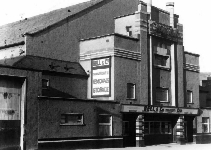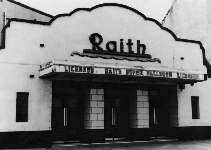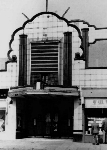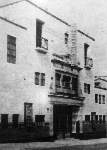Art Deco and Jazz Moderne [Part 1]
The term Art Deco was derived from the 1925 Paris Exposition des Arts
Décoratifs et Industriels Modernes, although as a style, it
pre-dated and outlived that exhibition. Stylistically, it ranged from
such avant-garde exhibits as Melnikov’s Soviet Pavilion and Le
Corbusier’s Pavillon De L’Esprit Nouveau to relatively
conventional beaux arts-influenced designs. As its title makes clear,
however, the exhibition gave prominence to the decorative arts and so
the Art Deco tag came to describe a style mixing late-Art Nouveau with
Colonial ‘jungle’ motifs and, later, imagery from popular
culture.
Far from being a pallid imitation of something else, true Art
Deco was a decorative subculture entirely unto itself. Art Deco
buildings were distinguished by vigorous ornamentation - multi-layered
recesses and exotic Egyptian, Mayan or ‘jazz’ imagery. They
were decorated with etched glass, vitrolite, chrome, gilding and
polychromatic tiles - and all the parts contributed towards to their
visual climax - balconies, ironwork, lamps, graphics, windows, doors
and parapets. The full-blown Art Deco style was relatively uncommon in
Britain and was usually heavily diluted. In architecture, it was most
popular in America, simultaneously taking on the sophisticated
metropolitan look of such New York skyscrapers as the Chanin and
Chrysler buildings and the tropical look of Miami Beach. Art Deco
probably fed into British entertainment architecture as much through
our attraction to American culture - especially the ‘screen
deco’ of Hollywood movies – as through the direct influence
of the Paris exhibition.
Jazz moderne was a mainly British and American derivative of Art Deco,
inspired by the syncopated rhythms suggested by jazz music and the
bright colours found in cubist painting, expressionism and De Stijl. It
found brief popularity in commercial architecture and shop fitting
during the late 1920s and early 1930s, but was much derided by
‘serious’ architectural commentators. While true Art Deco
tended towards opulent excess, jazz moderne relied on cheap painted
zigzag and wave patterns, bright clashing colours and
‘sunburst’ motifs. The style had a longer impact in home
furnishings – rugs, carpets, upholstery, ceramics and the
ubiquitous ‘sunburst’ suburban garden gate.
 |
McKissack’s first commissions in these styles were for Robert
McLaughlin’s Edinburgh Cinema Properties circuit (for whom he had
converted the Caley
cinema some years previously). Edinburgh was not an
easy place for would-be cinema developers. Its city centre was already
densely developed. The Old Town had few large enough sites to be
worthwhile and the Georgian New Town was a ‘fait accompli’
, and so most projects in the 1930s served newly built suburbs, be they
municipal or private developments. James McKissack designed a series of
medium-sized super cinemas for various subsidiaries of Robert
McLaughlin’s circuit to serve Edinburgh’s new peripheral
housing estates. – such as the Carlton, Piershill. |
He also
designed the Raith in Kirkcaldy, Fife for the same owner. While the
former two were of conventional appearance, an idiosyncratic
cloud-shaped entrance portico distinguished the entrance to the Raith.
McKissack gave a similar treatment to the Embassy in Troon, designed
for another of his important clients, the Ayrshire-based K.R. Blair
circuit (which also ran cinemas in Irvine, Beith and Girvan).
Altogether, McKissack worked mainly for four cinema proprietors,
located right across Central Scotland. His most important designs were
for Glasgow-based circuits.
That city had been in perpetual expansion since the Industrial
Revolution and in the 1930s it increased further with new garden
suburbs of bungalows for the middle classes and further municipal
housing schemes to relieve inner city congestion. Glasgow was regarded
by the film industry as ‘Cinema City’ and the CEA
established that the average Glaswegian must have gone to the cinema a
staggering fifty one times a year to achieve the attendance figures
recorded in the late 1930s. This is remarkable as some people,
particularly in prosperous areas, rarely if ever went to see a film,
preferring the city’s many live theatres; the others simply went
several times a week.
|

 |
With 139 cinemas in business at the outbreak of
the Second World War (Edinburgh had only 65) , Glasgow could boast more
cinema seats per head of population than any other city in the country
and these were evidently occupied more often than those in Manchester,
the city with the next highest ratio.
In Glasgow, McKissack designed exclusively for the Smith and Welsh and
Singleton circuits. Smith and Welsh, it will be remembered, were Labour
councillors; Smith being the city’s Housing Convenor, and thus
whenever a new municipal development was proposed in the 1930s, a
cinema for Smith and Welsh to a McKissack design was sure to be
included on a prominent site. Today, such an apparent conflict of
interest might well cause political scandal but, equally, Smith and
Welsh were ensuring that the occupants of Glasgow’s new housing
schemes enjoyed the use of large and spacious cinemas, which were
much-needed recreational amenities.
The
Mecca in Possilpark, then thought to be a model of municipal
housing design, was the first of these outer suburban schemes and was
completed in 1932. It was unusual in that the auditorium was
essentially an asbestos cement-clad ‘tent’ over steel
frames, yet the façade to Balmore Road was, in contrast, a
sturdy composition of red sandstone, faience and harling. It looked
well when viewed square on, but its side elevation to Hawthorn Street
was (and still is) messy and reveals the essential cheapness of its
construction.
 |
None-the-less, internally the Mecca was colourfully
decorated in ‘jazz moderne’ style with stained glass lights
in the stairwells, robust terrazzo flooring in the hallways and an
ornate proscenium arch and curtains, adorned with waves and zigzag
motifs.
Also dating from 1932, the lumpish Regal at Stranraer was truly an ugly
intrusion into the townscape. This medium-sized provincial cinema was
built for a local syndicate (which may have been working to an
extremely tight budget) and it presented to the street a tall and
rather poorly resolved expanse of harled brickwork, within which a
small faience-clad entrance portico was buried. |